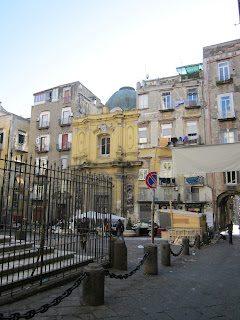One of the features of the park that I think is fantastic beyond all that is fantastic is the 3 km long “pond” with a 70 foot tall cascade at the end of it. After the cramped quarters of the Centro Historico in Naples, the open English style park with its great wazzok of a “pond” is rather nice. As with the palace itself the impression is one of overwhelming size, quantity rather than quality. This is sad because there are actually some really amazing sculptures here, they just get a little lost in the sheer vastness of it all.
To walk around the pond/canal it takes about an hour with stopping at each fountain and terrace for a good look and photo op. I would recommend taking an umbrella if it is drizzling or raining. The ornamental trees provide little protection from the elements.
There are tons of sculptures, mostly in collected groups: the arts, the sciences, personifications of architecture, geography etc. and urns supported by tritons and putti. I bet in the summer it must be delightful, but around about New Year’s it’s a little depressing, especially with the drizzle and fog. The sheer size makes up for it though, damned impressive.
Every quarter kilometer or so one comes to a new fountain and or terrace. Each with it's own theme and dripping with ornament and sculpture.
First up is the fountain of dolphins. They are sort of proto-evolution dolphins as they have claws and are actually rather terrifying. If marvelously sculpted in a grotesquely fantastic way.
 |
| Can't sleep the dolphins will eat me! |
Next up is the Fountain of Aeolus. Here is a sort of grotto with several dozen zephyrs spouting water jets.
 |
| Fountain of Aeolus. I'd love to get in that artificial grotto, it looks cool! |
After the fountain of Aeolus comes the Fountain of Ceres. I think she is holding a medallion of Persephone?
 |
| Ceres, being all fountain like. |
The palace gets further and further away.
 |
| It's gonna be a long walk back. |
The fountain of Venus and Adonis is next.
Not entirely sure what is going on in this sculpture but it looks darn sexy.
 |
| Add caption |
Finally the statue of Diana and Actaeon, the unfortunate peeping Tom. For his crime of catching the goddess Diana in the nude he was turned into a stag and torn apart by hunting dogs. Nice! Give me that old time religion. The cascade leads from a grotto about 200 feet above the fountain.
 |
| Fountain of Diana and Actaeon. |
Someone liked to sculpt dogs methinks. Here's Actaeon getting torn apart:
And here's Diana with all her bathing attendants. It suddenly all becomes clear:
One last look at the cascade from close up and back to the palace. During the summer there are acres of garden to explore.














